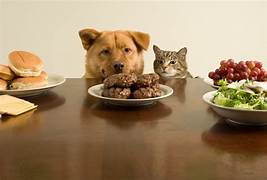
Toxic Foods Pets Should Never Eat.
Many everyday foods that are harmless or healthy for humans can be extremely dangerous—or even deadly—for pets. From chocolate and grapes to onions and xylitol, understanding which foods to avoid is essential for every pet owner. This article explores toxic foods, their effects, emergency signs, and how to keep your beloved animals safe and healthy.
🐶 Pet Star
37 min read · 3, Jul 2025

Introduction
Our furry companions—whether dogs, cats, or other pets—are often seen as beloved family members. Naturally, many pet owners want to share their meals or treats with their animals. However, what’s safe for human consumption can be deadly for pets. A wide variety of everyday foods that humans enjoy can cause severe illness or even death in animals. Toxicity in pets depends on the type of food, the amount ingested, the size and species of the animal, and even individual health factors. In this article, we will dive deep into the foods that pets should never eat, explaining the science behind their toxicity, symptoms of poisoning, emergency response tips, and safe alternatives.
Chapter 1: Why Pets Can't Eat What We Eat
While humans have evolved to handle a broad spectrum of foods, animals have different digestive systems, metabolic rates, and organ sensitivities. Certain enzymes present in humans to break down compounds found in common foods are absent in pets. For example, theobromine in chocolate is easily metabolized by humans but remains in a dog’s system much longer, leading to toxic buildup.
Additionally, pets often lack the instinct to avoid harmful foods. A dog may gobble down an entire chocolate cake without hesitation. Therefore, it’s critical that pet owners act as gatekeepers, ensuring pets are only exposed to safe, species-appropriate foods.
Chapter 2: The Most Toxic Foods for Dogs and Cats
1. Chocolate
Chocolate is arguably the most well-known toxic food for dogs (and to a lesser extent, cats). It contains theobromine and caffeine, both methylxanthines that affect the central nervous system and heart.
Symptoms: Vomiting, diarrhea, restlessness, elevated heart rate, seizures, death (in large doses)
Most toxic types: Dark chocolate and unsweetened baking chocolate
Dangerous dose: As little as 20 mg/kg can cause mild symptoms
2. Grapes and Raisins
Even a small quantity of grapes or raisins can cause acute kidney failure in dogs. The exact toxin is still unknown, but the consequences are well-documented.
Symptoms: Lethargy, vomiting, diarrhea, loss of appetite, kidney failure
Dangerous dose: As few as 4–5 grapes or raisins for small dogs
3. Onions, Garlic, and Chives
These alliums contain compounds that can damage red blood cells, leading to hemolytic anemia in both dogs and cats.
Symptoms: Weakness, pale gums, vomiting, abdominal pain, collapse
Forms: Raw, cooked, powdered (especially dangerous in baby food or meat seasoning)
4. Xylitol (Artificial Sweetener)
Common in sugar-free gum, candy, toothpaste, and some baked goods, xylitol can cause a rapid insulin release in dogs, resulting in life-threatening hypoglycemia.
Symptoms: Weakness, confusion, tremors, seizures, liver failure
Dangerous dose: 50 mg per pound of body weight
5. Alcohol
Alcohol has a far more dramatic effect on pets than on humans. Even small amounts can lead to ethanol poisoning.
Symptoms: Vomiting, disorientation, slow breathing, coma, death
Sources: Alcoholic beverages, mouthwash, fermented foods
6. Macadamia Nuts
Toxic specifically to dogs, macadamia nuts can cause a temporary but painful illness.
Symptoms: Weakness, vomiting, hyperthermia, tremors
Onset: Within 12 hours of ingestion
7. Caffeine
Found in coffee, tea, energy drinks, and even some medications, caffeine is a potent stimulant.
Symptoms: Hyperactivity, rapid breathing, heart palpitations, seizures
8. Raw Yeast Dough
The yeast continues to rise in the pet’s warm stomach, potentially causing bloating and alcohol poisoning as the fermentation process produces ethanol.
Symptoms: Bloating, pain, unsteady walking, lethargy, collapse
9. Bones (Especially Cooked)
Though it’s a popular belief that dogs love bones, cooked bones can splinter and cause intestinal blockages or perforations. Raw bones can sometimes carry pathogens like Salmonella.
Symptoms: Choking, vomiting, constipation, internal bleeding
10. Dairy Products
Many pets, especially adult cats and some dog breeds, are lactose intolerant.
Symptoms: Diarrhea, gas, stomach cramps
Note: A tiny amount of cheese may be tolerated by some pets but should not be a staple.
Chapter 3: Species-Specific Dangers
For Dogs
- Avocados: Contain persin, which can cause vomiting and diarrhea.
- Nutmeg: Causes hallucinations and tremors.
- Raw eggs: Risk of salmonella and biotin deficiency.
For Cats
- Tuna (in excess): Can cause mercury poisoning.
- Dog food: Lacks essential taurine and nutrients for cats.
- Citrus oils: Toxic to the liver and can cause tremors.
For Birds
- Chocolate, alcohol, avocado, caffeine, fruit pits, and onions are all highly toxic.
- Birds have extremely delicate systems and need a strictly monitored diet.
Chapter 4: Signs of Food Toxicity in Pets
Recognizing the symptoms early can be life-saving. Look for:
- Vomiting or diarrhea
- Excessive drooling or foaming at the mouth
- Lethargy or hyperactivity
- Seizures or tremors
- Pale gums or yellowing of the eyes
- Sudden behavioral changes
When in doubt, call a veterinarian or poison control hotline immediately.
Chapter 5: What To Do If Your Pet Ingests a Toxic Food
- Don’t panic, but act quickly.
- Identify the food and how much was eaten.
- Call your vet or the ASPCA Animal Poison Control Center.
- Don’t induce vomiting unless specifically advised by a professional.
- Bring the food packaging and your pet to the vet if instructed.
Emergency hotlines (U.S.):
- ASPCA Poison Control: 1-888-426-4435
- Pet Poison Helpline: 1-855-764-7661
Chapter 6: Safe Alternatives and Preventive Measures
Instead of sharing table scraps, offer pet-safe treats:
- Carrots, apples (no seeds), green beans, and plain cooked pumpkin
- Commercially prepared pet treats with vet approval
- Ensure food storage is secure and trash cans are pet-proof
- Educate family members and children about pet food safety
Pets are treasured members of the family, and as such, many pet owners love sharing their lives—and occasionally their meals—with them. While this might seem like a loving gesture, it can sometimes turn fatal. Pets, especially dogs and cats, have physiological and metabolic systems vastly different from humans. This means that what may be safe and even healthy for a person can prove highly toxic to an animal. Understanding these differences is critical for responsible pet ownership. One of the most well-known toxic foods for dogs is chocolate. It contains theobromine and caffeine, both stimulants from the methylxanthine group. While humans metabolize these compounds relatively quickly, dogs process them much slower, allowing the toxic elements to accumulate in the system. Even a small amount of dark or baking chocolate can lead to vomiting, diarrhea, restlessness, tremors, seizures, or even death. Another dangerous item is grapes and raisins, which can cause acute kidney failure in dogs. The exact toxin is still unidentified, but the effects are immediate and severe—just a few grapes can be deadly to a small dog. Onions, garlic, chives, and other allium family vegetables are also major culprits. These contain compounds that can damage red blood cells in both dogs and cats, leading to hemolytic anemia. The damage can accumulate over time or hit hard after a single large serving, especially with concentrated forms like garlic powder. Moving on to sugar substitutes, xylitol is found in sugar-free gum, baked goods, and even some peanut butters. It’s incredibly dangerous to dogs, as it triggers a rapid release of insulin that can cause hypoglycemia (low blood sugar) and potential liver failure. Even a single piece of xylitol-containing gum can result in fatal consequences. Alcohol is another hazard. Pets can be exposed to it through drinks, mouthwash, raw bread dough (which ferments in the stomach), or even spoiled fruit. Ethanol poisoning causes vomiting, disorientation, respiratory distress, coma, and death. Macadamia nuts, though considered a luxury snack for humans, can lead to muscle tremors, vomiting, and weakness in dogs. The toxin affects the nervous system, although symptoms typically resolve within 48 hours with treatment. Caffeine, found in coffee, tea, energy drinks, and chocolate, acts as a stimulant and affects pets even in small quantities. It can cause hyperactivity, heart arrhythmias, tremors, seizures, and death. Raw yeast dough presents two dangers: as it rises, it expands in the warm, moist environment of the pet’s stomach, potentially causing dangerous bloating. Additionally, fermentation produces alcohol, leading to ethanol toxicity. Cooked bones, especially from poultry, may seem like a treat to dogs, but they are dangerous because they splinter easily, potentially causing choking or tearing of the digestive tract. Raw bones, though less likely to splinter, can harbor pathogens like Salmonella. Dairy products might appear harmless, but many adult dogs and cats are lactose intolerant, meaning they lack the enzyme lactase needed to digest lactose in milk. Consuming cheese, milk, or ice cream can lead to bloating, gas, and diarrhea. Beyond the common offenders, there are species-specific dangers too. Cats, for example, are particularly vulnerable to essential oil toxicity, such as citrus oils. Tuna, while often fed to cats, can lead to mercury poisoning if given excessively. Additionally, feeding cats dog food deprives them of taurine, an amino acid essential for their heart and vision health. For birds, the dangers are even more expansive. Birds have incredibly fast metabolisms and fragile systems, making them highly sensitive to toxins. Even a small nibble of chocolate, avocado, caffeine, alcohol, or the seeds of fruits like apples or peaches can be fatal. Recognizing the signs of toxicity is crucial for timely intervention. Common symptoms include vomiting, diarrhea, drooling, lethargy, tremors, seizures, abdominal pain, pale or yellow gums, and changes in behavior. These symptoms may appear minutes to hours after ingestion depending on the substance. Any unusual symptom following suspected food ingestion should be treated as an emergency.
When a pet has ingested a toxic food, time is of the essence. Owners should remain calm but act immediately. First, identify the substance and estimate how much the pet consumed. Next, contact a veterinarian or a 24-hour poison control hotline such as the ASPCA Poison Control Center (1-888-426-4435) or the Pet Poison Helpline (1-855-764-7661). These services often require a consultation fee but can provide life-saving advice. Do not induce vomiting unless specifically instructed by a veterinary professional, as doing so in the wrong circumstance can cause more harm, especially if the pet is already showing neurological symptoms. If a vet visit is necessary, bring along the packaging of the ingested food or item to help professionals identify the toxin and dosage. It's also useful to record the pet’s weight, breed, and any symptoms noticed. Many food toxicities can be treated successfully if action is taken promptly. Preventing accidental poisoning requires awareness and proactive measures. Pet owners should ensure that harmful foods are stored securely in cupboards or refrigerators that pets cannot access. Garbage cans should be pet-proofed with secure lids or placed in areas pets can't reach. Owners must be vigilant during holidays, parties, and family gatherings when rich and varied foods are easily accessible and guests may unknowingly offer pets toxic treats. Educating all members of the household, including children, about foods that are unsafe for pets can go a long way in prevention. Additionally, being cautious with leftovers, food wrappers, and dishwashing practices can minimize risks. Some pets, especially dogs, will scavenge for scraps in dishwashers or trash, making post-meal cleanup an important time for supervision. Instead of table scraps, pets should be offered safe, species-appropriate treats. Healthy snack options for dogs include small pieces of carrot, green beans, apple slices (without seeds), and plain cooked pumpkin, which can aid digestion. Cats may enjoy freeze-dried meat treats or a lick of pureed chicken. Birds can enjoy tiny amounts of safe fruits and vegetables such as blueberries, broccoli, or spinach, provided they’re washed and chopped appropriately. Commercial treats approved by veterinarians are another safe alternative. Ultimately, pet owners must remember that pets are not miniature humans. Their unique biology makes them vulnerable to substances we take for granted. Toxic food ingestion is one of the most common emergencies veterinarians see—and yet, it’s entirely preventable with proper knowledge and care. With that said, always consult your veterinarian before introducing any new food into your pet’s diet. A seemingly innocent snack can sometimes become a life-threatening emergency. Responsible pet care involves understanding not just what pets should eat but, equally, what they must never consume. By building awareness, educating households, and practicing preventive habits, we can ensure that our beloved companions live healthier, longer, and safer lives. The comfort of feeding a pet something “from the table” is fleeting, but the consequences can be lasting. Sharing love doesn’t mean sharing food—especially when that food could be toxic. Let your vet be your best guide. And always err on the side of caution. If in doubt, keep it out of your pet’s bowl.
Conclusion
Toxic food ingestion is a common yet preventable emergency in veterinary care. Many human foods—from chocolate and grapes to xylitol and onions—can pose severe health risks to dogs, cats, and other pets. The key to protecting our animals lies in education, awareness, and proactive prevention.
Always consult with your veterinarian before introducing any new food into your pet’s diet. Remember, a moment of indulgence could result in a lifetime of regret if it leads to poisoning.
Q&A Section
Q1: - What should I do if my dog eats chocolate?
Ans: - Call your veterinarian immediately. The amount and type of chocolate will determine the level of toxicity. Never wait for symptoms to appear.
Q2: - Is it safe to give my cat a bit of tuna?
Ans: - Occasionally, yes, but it should not be a staple. Too much tuna can cause mercury poisoning and nutritional imbalances.
Q3: - Can dogs eat cheese or milk?
Ans: - Some dogs can tolerate small amounts, but many are lactose intolerant. Dairy can cause stomach upset, so it’s best given sparingly.
Q4: - Why are grapes and raisins dangerous for dogs?
Ans: - The exact toxin is unknown, but they can cause acute kidney failure, even in small amounts. Avoid entirely.
Q5: - Are cooked bones safe for dogs?
Ans: - No. Cooked bones can splinter and cause choking, blockages, or intestinal tears. Raw bones are safer but still pose risks.
Similar Articles
Find more relatable content in similar Articles

Virtual Vet Visits: Are Online Consultations Reliable?..
As pet healthcare embraces dig.. Read More

Social Media for Pets: Turning Your Pet into a Digital..
From playful puppies to charis.. Read More

Composting Pet Waste: A Greener Way to Clean Up...
As pet ownership continues to .. Read More

Pets and Mental Health: The Science Behind Emotional H..
Discover the profound impact o.. Read More
Explore Other Categories
© 2024 Copyrights by rPets. All Rights Reserved.